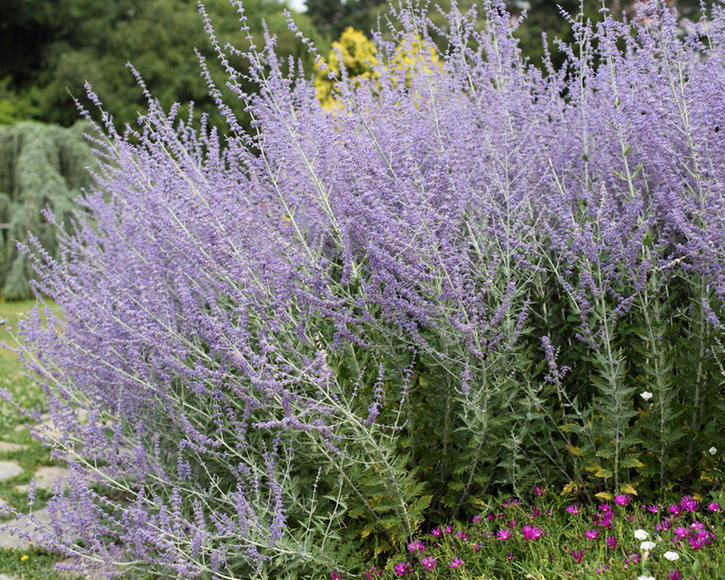Russian sage, blue spire
The Russian sage, also known as the blue spire, decorates rock gardens with its deep blue labiate flowers. We show you how to plant and care for it.
Factsheet
- Growth type
-
- half shrub
- Growth height (from)
- from 100 cm to 200 cm
- Growth width (from)
- from 50 cm to 100 cm
- Growth characteristics
-
- upright
- loosely
- Flower color
-
- purple
- blue
- Flowering time (month)
-
- August to September
- Flower shape
-
- lip-shaped
- panicles
- Leaf color
-
- green
- page format
-
- ovoid-lanceolate
- sawn
- Sheet properties
-
- fragrant
- Fruit shape
-
- nut fruit
- Light
-
- sunny
- Soil type
-
- stony to sandy
- Soil Moisture
-
- dry
- ph value
-
- alkaline to weakly acidic
- Lime compatibility
-
- lime-loving
- Nutrient requirements
-
- low in nutrients
- Humus
-
- low humus
- Decorative or utility value
-
- Flower Decoration
- Nectar or pollen plant
- Winter Hardness
-
- hardy
- Climate zones according to USDA
-
- 7
- areas of life
-
- FR1
- Use
-
- Single position
- Group planting
- Rose companion
- Dry stone walls
- Garden style
-
- Flower garden
- natural garden
- Stone Garden
- Bee Friendly
- bee friendly plant
The Russian sage (Perovskia atriplicifolia), also known as the Blue spire or Silver perovskia, is one of seven species of shrubs from the genus Perovskia within the family of the lamiaceae. The subshrub originally occurs in steppe areas and dry forests in Afghanistan, the Himalayas and Tibet. The species came to Europe in 1904 and is named after the Russian general and governor Vasilij Perovskij (1794-1857).
The Russian sage is a subshrub that grows loosely and upright and anywhere between 3.28 and 6.56 feet high during the flowering period.
Perovskia atriplicifolia forms rod-shaped, cylindrical and silvery-hairy shoots. The leaves are 1.18 to 2.36 inches long, ovate-lanceolate with rough and irregular serrations. At first they are hairy, later often bald and covered with yellow glands on both sides. The shoots and leaves smell pleasant.
From August to September the medium to deep blue labiate flowers appear, which form a panicle-like, up to 19.68 inches long inflorescence with two to six flowers in so-called pseudo whorls.

0.039 to 0.078 inch long nutlets are formed as fruits. They are surrounded by a 0.19 to 0.23 inch long white felt goblet.
Similar to its natural habitat, in dry steppe zones, Perovskia atriplicifolia also thrives in our garden in a location that’s warm and receives full sunlight - ideally in the rock garden.
The soil should be dry, very well drained, slightly acidic to alkaline and nutrient-poor.
It is advisable to plant the Russian sage in spring - either as a solitary shrub or in clusters, each with a planting distance of around 3.28 feet. Dig a planting hole that is twice the size of the root ball, plant the shrub in the ground and water it well.
Once it is rooted well, the blue spire does not need any special care measures, apart from additional watering during longer periods of drought. Fertilization is not necessary because the shrub prefers nutrient-poor soils.
The Russian sage freezes over the winter. Even if the shoots are not damaged, it is important to cut them off during spring, leaving about a hand's breadth from the ground. The strong pruning promotes the sprouting of new leaves and flowers in the coming year.
Perovskia atriplicifolia is particularly sensitive to moisture and cold in winter. It is therefore better to protect the root area in late autumn with a cover made of spruce branches, leaves or peat.
The silver-gray shoots, the fine texture of the foliage and the long flowering period make the Russian sage an attractive subshrub for stone and steppe gardens, for dry embankments and dry stone walls. Lavender (Lavendula), Sage (Salvia), Catmint (Nepeta) and other drought tolerant plants complement it well and even roses are suitable companion plants.

A popular variety with dark, lavender blue flowers is Perovskia atriplicifolia ‘Blue Spire’. In contrast to the pure species, the leaves of this variety are cut deeper and the inflorescences are longer. “Filigree” is a bushy variety that grows very compact and reaches a height of around 31.49 to 47.24 inches. Because of its compact growth and a height of only 19.68 inches, “Lacey Blue” is suitable for the foreground of beds and for planting pots. Make sure that there is a sufficient drainage layer, for example made of expanded clay or gravel. The variety Perovskia atriplicifolia “Little Spire” is also bushy and compact.
The Blue spire can be propagated in summer by using cuttings of herbaceous shoots as well as by division.
In general, the Russian sage is not affected by plant diseases and pests. Waterlogging should be avoided at all costs. It The steppe shrub does not grow upright on soils that are too rich in nutrients, instead it grows horizontally.

